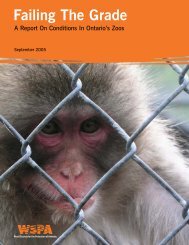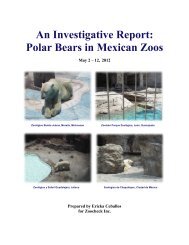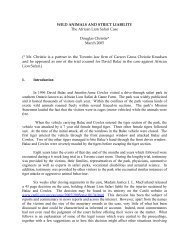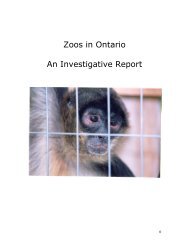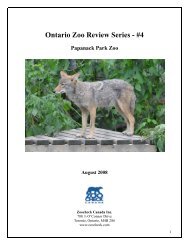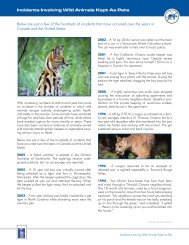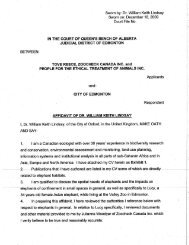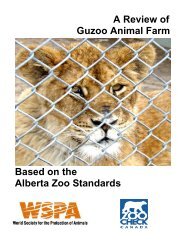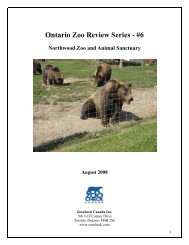STATUS OF BEAR WELFARE
STATUS OF BEAR WELFARE
STATUS OF BEAR WELFARE
Create successful ePaper yourself
Turn your PDF publications into a flip-book with our unique Google optimized e-Paper software.
Status of Bear Welfare in Cherokee, North Carolina<br />
All bears are physically and behaviorally structured to live on soft surfaces. Hard surfaces such<br />
as concrete are anathema to good bear husbandry because they are uncomfortable, may be<br />
physically damaging, and are inherently boring. All bears engage in a broad range of groundcentered<br />
behaviors, including but not limited to digging, rooting, and foraging; making various<br />
kinds of day beds, nests, and dens; self-medicating; etc. Concrete leaves the bear with nothing<br />
normal to do and is not an appropriate substrate for a primary enclosure.<br />
ABSENCE <strong>OF</strong> ESSENTIAL ENVIRONMENTAL<br />
ENRICHMENT<br />
The adult bears and cubs at all three Cherokee facilities were in desperate need of an extensive<br />
daily enrichment program. The concrete pits were devoid of any natural substrate that would<br />
provide the bears with materials to investigate, manipulate, use to construct day beds, or safely<br />
scratch against, dig in, or root in.<br />
Environmental enrichment is a vital part of basic, essential bear husbandry. The purpose of<br />
enrichment is to help create a complex and suitable living environment for the bear. Researchers<br />
conclude that bears are inquisitive, playful, intelligent, and highly manipulative, devoting a large<br />
part of their day to foraging for food. 5 While enrichment is necessary in most captive<br />
environments, it does not replace the need for a properly designed enclosure.<br />
Structural enhancements, furnishings, and other forms of enrichment serve a number of<br />
functions. They encourage species-typical movement and behavior (including exploratory seeking<br />
and foraging behavior), provide different microclimates for thermoregulatory actions, provide<br />
privacy from visitor view and conspecifics, reduce intraspecific competition and aggression,<br />
provide climbing opportunities, increase functional space, facilitate sensory-enrichment<br />
strategies, and provide olfactory and visual stimulation through the use of elevated perches to<br />
allow bears to catch windborne smells as well as to see beyond the confines of the enclosure.<br />
A great deal of a bear’s behavioral repertoire is directed at foraging for food, and a considerable<br />
portion of a bear’s daily time budget is devoted to food acquisition, especially during the fall when<br />
many bears must accumulate substantive fat reserves. Proper behavior-based husbandry<br />
dictates that foods must be presented in enrichment-style feedings (through scatter feeds, puzzle<br />
feeders, lunch-sized bags and boxes, and any other enrichment format that encourages normal<br />
bear foraging behavior).<br />
There was at least one bear at CSBP whose fur was matted, likely because of a lack of<br />
furnishings to rub against in order to discard naturally shed hairs. Shedding of fur is an ongoing<br />
process, but the majority of it occurs in the spring and is typically over by early summer for bears<br />
with access to trees, big rocks, or other appropriate rubbing structures. Matted fur can cause<br />
itching and skin irritation and interfere with temperature regulation. Well-groomed fur creates an<br />
envelope of temperate air between the bear’s skin and the environment. Matted fur can make the<br />
bear overheat in the summer and be cold in the winter.<br />
AN INVESTIGATIVE REPORT <strong>OF</strong> CHIEF SAUNOOKE <strong>BEAR</strong> PARK, CHEROKEE <strong>BEAR</strong> ZOO, AND SANTA’S LAND | 23





